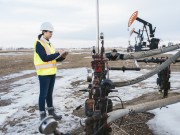When the final text of the Paris Agreement was gavelled on Saturday evening, thousands of people in the room – from business leaders, climate activists, to UN negotiators – were overwhelmed with relief, excitement and exhaustion. The agreement marks decades of international diplomacy efforts to solve climate change, one of the planet’s most pressing – and most interconnected – problems. But the real work starts now.
For the first time, all signatory nations have committed to a legally-binding agreement that recognizes the urgent threat of climate change. The agreement aims to limit global temperature increase to “well below 2 degrees Celsius above pre-industrial levels” and encourages all countries to “pursue efforts to limit temperature increase to 1.5 degrees Celsius”.
These temperature goals demonstrate a near-global consensus on the urgent need to transition to a low-carbon economy.
Importantly, the Paris Agreement also makes reference to mid-century emissions reductions goals. The text states that in order to achieve the temperature goals, the world must see a “peaking of greenhouse gas emissions as soon as possible” and that all countries must undertake “rapid reductions […] so as to achieve a balance between anthropogenic emissions by sources and removals by sinks of greenhouse gas emissions in the second half of the century”.
 In less convoluted terms, this agreement calls for near total cuts to carbon pollution in the next 35 years. For Canada, this means transitioning away from polluting sources of energy like oil, coal and gas, and towards low-carbon solutions for electricity, transportation, buildings and other important sectors of the economy. There are still many details to be worked out, but one thing’s for sure: the world just confirmed that polluting fossil fuels have overstayed their welcome and are being shown the door. The conversation is not if the world transitions away from fossil fuels – but rather how, and how quickly.
In less convoluted terms, this agreement calls for near total cuts to carbon pollution in the next 35 years. For Canada, this means transitioning away from polluting sources of energy like oil, coal and gas, and towards low-carbon solutions for electricity, transportation, buildings and other important sectors of the economy. There are still many details to be worked out, but one thing’s for sure: the world just confirmed that polluting fossil fuels have overstayed their welcome and are being shown the door. The conversation is not if the world transitions away from fossil fuels – but rather how, and how quickly.
The end of the fossil fuel era
Prominent voices – from business leaders to climate activists – were repeating a similar catch-phrase on Saturday: that the Paris Agreement marks “the end of the fossil fuel era”.
Long-time climate advocate, former U.S. Vice President Al Gore championed this framing following the gavel drop on Saturday, as he wrote, “this universal and ambitious agreement sends a clear signal to governments, businesses, and investors everywhere: the transformation of our global economy from one fuelled by dirty energy to one fuelled by sustainable economic growth is now firmly and inevitably under way”.
Just weeks before the climate talks began, U.S. President Barack Obama rejected the contentious Keystone XL pipeline project, in large part because of its role in spurring new oilsands development, and the associated climate impact. This marked the first time a head of state rejected an infrastructure project on the basis of climate change.
Canada must heed this important precedent, especially in the context of the new Paris Agreement. Reducing the country’s emissions will require significant reductions across all sectors of the economy – but especially so in the oil and gas sector. Emissions from this sector account for nearly one quarter of all emissions in Canada.
Transitioning away from fossil fuels will require Canada to get serious about how it evaluates the long-term carbon impacts associated with fossil fuel projects and infrastructure. Through environmental assessments, the federal government plays an important role evaluating the social and environmental consequences of new fossil fuel projects – but to date, has done an inadequate job ensuring that climate change is meaningfully considered in these reviews.
To rectify this, and to ensure carbon-intensive infrastructure doesn’t stymie national ambitions on climate change, the federal government should require all fossil fuel projects – including “in situ” oilsands, LNG projects in B.C., and pipeline infrastructure – to complete a rigorous climate test at the regulatory evaluation stage. In line with the U.S. precedent on pipelines, the federal government should ensure all projects are reviewed with an eye to their impact on Canada’s ability to secure absolute emissions reductions in the near-term, and keep up with its international climate obligations.
Ramping up policy action at home
Canada played an important and constructive role at the Paris climate talks. Many have said that Minister McKenna’s efforts to support the 1.5 degrees Celsius temperature limit made a material difference in the negotiations. But now, all eyes are on domestic climate policy, as the minister and her team translate those international ambitions into policy action here at home.
If Canada is going to contribute its fair share of emissions reductions towards the 1.5 degrees Celsius or 2 degrees Celsius limit, it will need to decarbonize its economy by mid-century. This will mean reducing emissions by at least 80 per cent relative to Canada's current levels in the next 35 years. To make this happen, we need to start bending Canada’s emissions curve immediately. Securing these carbon reductions will require a sea-change of new policies to send appropriate price signals to businesses and consumers alike. Fortunately, the federal government has a few immediate options it can pursue once the Paris jet lag wears off:
1. Policy support to green Canada’s electricity grid
In a decarbonized Canada, there’s no room for dirty coal-fired electricity. Canada needs to move up its timelines for forcing coal to control its carbon emissions sooner than the 50-year blank cheque to emit that the Harper government gave coal plants. Will the federal government repair the previous government's capitulation to coal companies and ensure that provinces move to renewables sooner? Doing so would secure emissions reductions from the electricity sector in places like Alberta and Saskatchewan, both of which are highly reliant on this polluting form of electricity production.
2. Financial and policy support for low-carbon businesses
The federal government should move quickly to develop financial tools to encourage clean energy entrepreneurship. "Green bonds" would allow Canadians to invest their nest eggs in safe climate-saving business and help dismantle barriers to clean energy across the country. The federal government can also recapitalize Sustainable Development Technology Canada, starting with the 2016 budget, to ensure it continues to play a critical role in supporting clean energy technologies.
3. A credible climate test for all fossil fuel projects and related infrastructure
The National Energy Board is in the process of reviewing two proposed pipeline projects: Kinder Morgan’s TransMountain Expansion, and TransCanada’s Energy East. Both projects would have multi-decade lifespans, and would enable new carbon emissions from Canada's oil and gas sector.
It’s clear that climate change must be a key consideration for all energy infrastructure projects going forward. The federal government must ensure these projects are not at odds with Canada's commitment to the Paris Agreement. During the election campaign, the Liberal party committed to modernizing the National Energy Board's review process. This included a commitment to evaluate upstream carbon emissions in environmental assessments for projects like the TransMountain Expansion and the Energy East pipelines. We encourage Canada’s new federal government to outline the steps it will take to ensure these projects have a meaningful climate change review at the National Energy Board.
From here on out, the climate implications of every decision our government makes must be measured against the world’s 1.5 degrees temperature goal. For too long, Canada made climate commitments it had no intention of keeping. Conditions are ripe for transformative change, so now we must ask: does Canada finally have a government serious about keeping its climate promises? We sure hope so.







